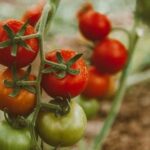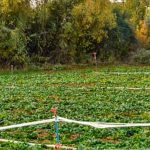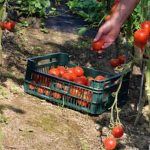Are you interested in starting a vegetable garden in New England? Whether you’re a seasoned gardener or just beginning, there are many factors to consider when it comes to growing vegetables in this region. From the specific vegetables that thrive in the climate to the soil preparation and maintenance required, New England vegetable gardening offers its own unique set of challenges and rewards.
New England’s diverse climate and seasonal changes provide a rich environment for a variety of vegetables to flourish. The key to successful gardening in this region lies in understanding the best practices for planting, maintaining, and harvesting your vegetable garden. From choosing the right vegetables to preparing the soil and dealing with pests and diseases, there is much to learn about New England vegetable gardening.
In this comprehensive guide, we will explore the ins and outs of New England vegetable gardening. From the best vegetables to grow in this region to tips for successful gardening, we will cover everything you need to know to start your own thriving vegetable garden in New England. So grab your gardening gloves and get ready to embrace the joys of growing your own fresh produce right at home.
Best Vegetables to Grow in New England
When it comes to New England vegetable gardening, choosing the right vegetables to grow is essential for a successful and bountiful harvest. The region’s unique climate and soil conditions make it ideal for certain types of vegetables that thrive in cooler temperatures. Here are some of the best vegetables to consider for your New England garden:
Root Vegetables
Root vegetables such as carrots, beets, radishes, and turnips are well-suited for New England’s soil and climate. They can withstand the region’s cooler temperatures and are relatively low-maintenance, making them great choices for beginner gardeners.
Leafy Greens
Leafy greens like lettuce, kale, spinach, and Swiss chard are also excellent choices for New England vegetable gardening. These fast-growing vegetables can be planted early in the spring and late in the summer for a continuous harvest throughout the growing season.
Cruciferous Vegetables
Cruciferous vegetables such as broccoli, Brussels sprouts, cauliflower, and cabbage are cold-hardy and can thrive in New England’s climate. With proper care and maintenance, these nutritious vegetables can provide a plentiful yield for your kitchen table.
In addition to these options, other suitable vegetables for New England vegetable gardening include peas, beans, potatoes, onions, garlic, and certain herbs like parsley, thyme, and cilantro. By selecting the right mix of vegetables that align with the region’s growing conditions, you can look forward to a diverse and productive garden that reflects the unique flavors of New England.
Soil Preparation and Maintenance for New England Vegetable Gardening
When it comes to successful New England vegetable gardening, soil preparation and maintenance are crucial. The unique climate and soil conditions of the region require special attention in order to ensure healthy and thriving plants. Whether you’re a seasoned gardener or just starting out, taking the time to properly prepare and maintain your soil will greatly improve your chances of a bountiful harvest.
One important aspect of soil preparation for New England vegetable gardening is the addition of organic matter. Compost, aged manure, and other organic materials can improve soil structure, drainage, and nutrient content. In New England, where the soil tends to be rocky and acidic, adding organic matter can make a significant difference in the health of your plants.
In addition to adding organic matter, pH testing is essential for follow noopener”>New England vegetable gardening. Many vegetables prefer a slightly acidic soil with a pH between 6.0 and 6.8. If your soil is too acidic, adding lime can help balance the pH level.
On the other hand, if your soil is too alkaline, sulfur may be needed to lower the pH. Regular testing and adjustments will ensure that your vegetables have the optimal growing conditions they need to thrive in New England’s unique environment.
Climate and Seasonal Considerations for New England Vegetable Gardening
When it comes to New England vegetable gardening, it is crucial to consider the climate and seasonal variations of the region. New England experiences a temperate climate, with warm summers and cold winters. This means that vegetable gardeners need to carefully plan their planting schedule to ensure a successful harvest.
The growing season in New England typically runs from late spring to early fall, with the peak months being June through August. However, frosts can occur as early as September in some parts of the region, so it’s important to choose vegetable varieties that can withstand cooler temperatures or utilize season extending techniques such as row covers or cold frames.
In addition to temperature considerations, New England vegetable gardeners should also be mindful of rainfall patterns. While the region generally receives a moderate amount of precipitation throughout the year, there can be variations from year to year. It’s essential for gardeners to monitor soil moisture levels and irrigate their crops as necessary, especially during dry spells.
One popular practice among New England vegetable gardeners is succession planting, which involves sowing small amounts of seeds at regular intervals throughout the growing season to ensure a continuous harvest. This approach takes into account the changing climate and allows for a more efficient use of space and resources.
| Vegetable | Best Planting Time |
|---|---|
| Tomatoes | Transplants in late May or early June |
| Lettuce | Sow seeds in early spring and again in late summer for fall harvest |
| Pumpkins | Sow seeds indoors in April for transplanting outdoors after last frost |
Pests and Diseases Commonly Faced in New England Vegetable Gardens
Pests and diseases can pose a significant challenge to vegetable gardeners in New England. The region’s diverse climate and soil conditions make it susceptible to a variety of issues that can impact the health and yield of vegetable plants. In order to successfully navigate these challenges, it’s important for gardeners to be aware of the common pests and diseases they may encounter, as well as preventative measures and treatments.
Common Pests
One of the most pervasive pests in New England vegetable gardens is the Colorado potato beetle, which can devastate potato crops if left unchecked. Other common pests include aphids, cabbage worms, and squash bugs. These insects can quickly multiply and cause significant damage to vegetable plants if not properly managed.
Common Diseases
New England’s damp climate can create ideal conditions for fungal diseases such as powdery mildew, blight, and damping-off. Bacterial diseases like bacterial spot and wilt can also affect vegetable plants in the region. Identifying these diseases early is crucial in preventing their spread and minimizing their impact on the garden.
Preventative Measures
To protect their vegetable crops from pests and diseases, New England gardeners should consider implementing integrated pest management practices. This may include crop rotation, using row covers or netting to deter insects, and promoting overall plant health through proper watering, mulching, and spacing. Additionally, selecting resistant plant varieties can help minimize the risk of disease.
By being proactive in identifying potential issues, monitoring plant health regularly, and taking preventative actions when necessary, New England vegetable gardeners can minimize the impact of pests and diseases on their crops. Through careful attention to these concerns, gardeners can maximize their chances of a successful harvest in this unique growing region.
Tips for Successful New England Vegetable Gardening
New England Vegetable Gardening Tips:
When it comes to successful New England vegetable gardening, there are a few key tips to keep in mind. First and foremost, it’s important to choose vegetable varieties that are well-suited to the region’s climate and growing conditions. Some popular choices for New England vegetable gardens include tomatoes, peppers, squash, lettuce, and carrots. These vegetables are known for thriving in the cool springs and warm summers typically experienced in New England.
In addition to selecting the right vegetables, proper soil preparation is essential for successful New England vegetable gardening. New England soil tends to be acidic, so adding lime can help balance the pH levels. Additionally, incorporating organic matter such as compost or well-rotted manure can improve soil structure and fertility, providing a healthy foundation for your vegetable garden.
One of the challenges of New England vegetable gardening is navigating the region’s ever-changing weather patterns. It’s important for gardeners to pay close attention to local climate and seasonal considerations when planning their planting schedule and caring for their crops. By staying informed about upcoming weather patterns and understanding the specific needs of each vegetable variety, gardeners can adapt their practices accordingly and maximize their chances of success.
| New England Vegetable | Recommended Varieties |
|---|---|
| Tomatoes | Roma, Celebrity, Sungold |
| Peppers | Bell Peppers, Jalapeno Peppers |
| Squash | Zucchini, Butternut Squash |
| Lettuce | Bibb Lettuce, Romaine Lettuce |
Harvesting and Preserving Your New England Vegetable Garden
Now that you have successfully grown a bountiful vegetable garden in New England, it’s time to reap the rewards of your hard work. Harvesting your vegetables at the peak of ripeness is crucial for the best flavor and nutrition. Here are some tips for harvesting your vegetables:
- Harvest leafy greens such as lettuce and spinach by cutting individual leaves from the outer part of the plant, allowing the inner leaves to continue growing.
- Root vegetables like carrots and beets can be gently pulled from the ground, taking care not to damage the roots.
- Tomatoes, peppers, and cucumbers should be harvested when they are fully ripe to ensure the best taste.
Once you have harvested your vegetables, it’s important to properly preserve them to enjoy their flavors throughout the year. Canning, freezing, and pickling are common methods for preserving vegetables in New England. Here are some guidelines for preserving your harvest:
- Canning tomatoes and making tomato sauce is a popular way to preserve this abundant crop. Be sure to follow safety guidelines for proper canning techniques.
- Freezing peas, beans, and corn shortly after harvesting locks in their freshness. Blanching these vegetables before freezing helps maintain their color and texture.
- Pickling cucumbers with a mixture of vinegar, water, and spices creates delicious pickles that can be enjoyed long after the growing season has ended.
Preserving your harvest allows you to savor the flavors of your New England vegetable garden all year round. With careful harvesting and preservation techniques, you can enjoy the fruits of your labor well into the winter months.
Community and Resources for New England Vegetable Gardeners
When it comes to New England vegetable gardening, having access to a supportive community and valuable resources can make a significant difference in the success of your garden. Fortunately, there are numerous options available for those looking to connect with other like-minded individuals and obtain the information they need to thrive in this unique gardening environment.
- Local Gardening Clubs: Joining a local gardening club can provide you with the opportunity to network with experienced gardeners in your area. These clubs often host events, workshops, and plant sales that can be invaluable for beginners and seasoned gardeners alike.
- Extension Services: Many New England states have cooperative extension services that offer a wealth of information on gardening best practices specific to the region. These services often provide soil testing, pest identification, and educational programs tailored to New England vegetable gardening.
- Online Forums and Social Media Groups: The internet has made it easier than ever to connect with fellow gardeners from all over the world. Joining online forums or social media groups dedicated to New England vegetable gardening can give you access to a vast amount of knowledge and support from individuals who understand the challenges of gardening in this region.
In addition, many communities host farmers’ markets, seed swaps, and other events that are perfect for connecting with other vegetable gardeners in your area. By tapping into these community resources, you can gain valuable insights, build meaningful connections, and ultimately enhance your overall experience as a New England vegetable gardener.
Conclusion
In conclusion, New England vegetable gardening offers a unique and rewarding experience for both seasoned gardeners and beginners alike. Despite the region’s challenging climate and soil conditions, there is a wide variety of vegetables that can thrive in New England, from hardy root crops to leafy greens and colorful peppers. With proper soil preparation, pest management, and seasonal considerations, gardeners can enjoy a bountiful harvest that reflects the rich agricultural heritage of the region.
One of the joys of New England vegetable gardening is the sense of community and camaraderie among fellow gardeners. Whether it’s participating in local gardening clubs, attending workshops and events, or sharing tips with neighbors and friends, there are ample opportunities to connect with others who share a passion for gardening.
Additionally, there are plenty of resources available to support gardeners in their endeavors, such as cooperative extension services, seed exchanges, and online forums where knowledge and advice can be freely shared.
As we embrace the joys of New England vegetable gardening, we not only cultivate healthy and delicious produce but also foster a deep appreciation for the natural world. The act of tending to a garden teaches us patience, resilience, and the value of hard work.
It allows us to reconnect with nature’s rhythms and cycles while providing an opportunity for relaxation and reflection. So as we dig our hands into the earth, let us savor every moment and celebrate the abundance that comes from nurturing our own piece of land in this beautiful region known as New England.
Frequently Asked Questions
What Are the Best Vegetables to Grow in New England?
The best vegetables to grow in New England include cold-hardy varieties like broccoli, kale, carrots, and peas. These vegetables can withstand the region’s cooler temperatures and are well-suited for its short growing season.
When Can You Plant in New England?
In New England, the planting season usually begins in late April or early May when the risk of frost has passed. However, it’s important to pay attention to your specific location within New England as the climate can vary across the region.
When Should I Plant My Vegetable Garden in Massachusetts?
In Massachusetts, the best time to plant a vegetable garden is typically from late April to mid-May. This timing allows for the soil to warm up and reduces the risk of frost that could damage young plants. It’s also important to consider the specific planting times for different vegetables based on their individual needs.

If you’re looking to get into vegetable gardening, or are just looking for some tips on how to make your current garden better, then you’ve come to the right place! My name is Ethel and I have been gardening for years. In this blog, I’m going to share with you some of my best tips on how to create a successful vegetable garden.





